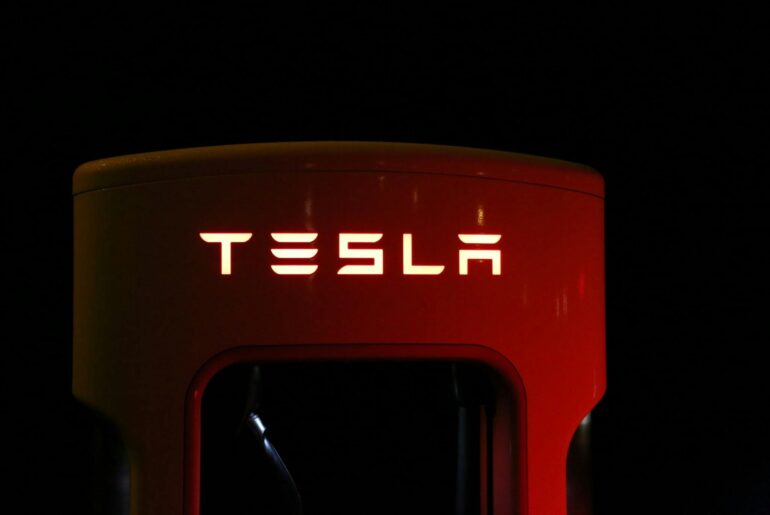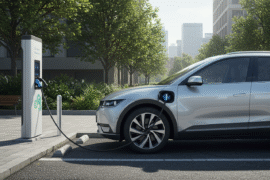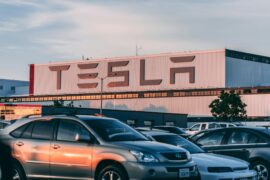This article may contain references to products or services from one or more of our advertisers or partners. We may receive compensation when you click on links to those products or services. Nonetheless, our opinions are our own.
The information presented in this article is accurate to the best of our knowledge at the time of publication. However, information is subject to change, and no guarantees are made about the continued accuracy or completeness of this content after its publication date.
Tesla continues to shape the future of electric mobility and renewable energy with innovations that influence the global automotive and clean energy industries. As of 2025, Tesla remains the largest manufacturer of battery electric vehicles (BEVs), with a global market share of approximately 17.6 percent. In 2023, Tesla delivered nearly 1.8 million vehicles worldwide, representing a 38 percent increase from 2022. The company’s success stems from continuous advancements in battery technology, software development, and a comprehensive energy product lineup. Despite this, Tesla faces multiple challenges including declining sales in key European markets, intensifying competition from emerging electric vehicle manufacturers such as BYD, and evolving regulatory landscapes. Furthermore, Tesla is expanding its operations beyond vehicles into energy storage, solar power, and artificial intelligence-driven autonomous technologies, which may redefine its long-term growth prospects.
This comprehensive analysis reviews Tesla’s recent strategic moves, current operational and financial performance, and forecasts its future opportunities and risks. The discussion includes a detailed examination of market dynamics, technological innovations, energy solutions, regulatory factors, and competitive positioning.
Tesla’s Recent Performance and Market Dynamics
| Metric | Details |
|---|---|
| Global Vehicle Deliveries | Approximately 1.8 million vehicles delivered in 2023. Q2 2025 deliveries decreased by 13.5% year-over-year to around 384,000 units. |
| Regional Market Performance | Significant sales declines in Europe: Germany (-55%), UK (-60%), France (-27%) during mid-2025. |
| Global EV Market Position | Tesla held a 17.6% share of the global BEV market in 2023 but faces increased pressure from competitors. |
| Competition | BYD, a Chinese EV manufacturer, overtook Tesla’s quarterly BEV sales with 1.1 million vehicles in Q2 2025. |
| Brand Loyalty | Tesla’s customer retention rate dropped from 73% in mid-2024 to approximately 50% in early 2025, with signs of slight recovery to 57% by May 2025. |
| Energy Storage Deployment | Tesla Energy deployed 9.6 gigawatt-hours (GWh) in Q2 2025, down from 10.4 GWh in the prior quarter. |
| Financial Highlights | Q2 2025 revenue declined approximately 12% year-over-year, affected by delivery drops and lower regulatory credits. |
Global Vehicle Deliveries Over the Past Four Quarters
| Quarter | Deliveries (Units) | Year-over-Year Growth (%) |
|---|---|---|
| Q3 2024 | 435,000 | +26 |
| Q4 2024 | 495,000 | +35 |
| Q1 2025 | 422,000 | -2 |
| Q2 2025 | 384,000 | -13.5 |
Market and Regulatory Environment
Tesla operates in a highly regulated and politically sensitive industry. Key governments worldwide are setting increasingly stringent emissions targets and providing subsidies to accelerate electric vehicle adoption. However, these policies vary by region and may shift with changing political priorities.
Government Incentives and Regulatory Impacts
| Region | Incentive/Regulation | Effect on Tesla |
|---|---|---|
| United States | Federal tax credits for EV purchases (up to $7,500) | Boosts consumer demand, but eligibility rules can limit model options. |
| European Union | Proposed CO2 emissions standards tightening in 2026 | Encourages automakers to sell more EVs, benefits Tesla’s pure EV lineup. |
| China | EV subsidies and license plate advantages | Supports local competitors but Tesla also benefits from strong demand. |
| Other markets | Growing charging infrastructure investment | Improves ownership experience, expands Tesla’s market potential. |
Tesla’s Technology and Innovation Focus
Battery Technology
Tesla’s competitive advantage relies heavily on its battery technology. The company continues to innovate in cell chemistry, manufacturing, and battery pack design.
-
Lithium Iron Phosphate (LFP) Batteries: Tesla has expanded the use of LFP batteries in Model 3 and Model Y vehicles for cost efficiency and raw material availability.
-
4680 Cell Development: These larger-format cells offer improved energy density and faster manufacturing. Tesla is scaling pilot production but widespread adoption is gradual.
-
Battery Recycling and Raw Materials: Tesla invests in battery recycling technology and seeks to secure raw material supplies through partnerships and mining investments to reduce dependence on external suppliers.
Autonomous Driving and Software
Tesla’s Autopilot and Full Self-Driving (FSD) features represent a critical growth area.
-
The company has deployed over 500,000 vehicles with FSD hardware, collecting vast data sets to improve neural network performance.
-
Robotaxi services are under limited testing, primarily in Austin, Texas, with expectations to expand as regulatory approvals progress.
-
Software improvements and over-the-air updates enable continuous feature enhancements, differentiating Tesla from traditional automakers.
Energy Solutions
Tesla Energy encompasses solar panels, Solar Roof, Powerwall home batteries, and large-scale energy storage projects.
-
Tesla’s energy storage installations exceeded 31 GWh in 2024, a 113% increase over the previous year with $10.1 billion in revenue.
-
Virtual power plant projects leverage distributed batteries to support grid stability and reduce energy costs.
-
Solar energy remains a smaller but growing component, with integration challenges and supply chain constraints impacting short-term growth.
Voted "Best Overall Budgeting App" by Forbes and WSJ
Monarch Money helps you budget, track spending, set goals, and plan your financial future—all in one app.
Get 50% OFF your first year with code MONARCHVIP
Competition and Market Challenges
Tesla’s dominance is challenged by established automakers increasing EV offerings and aggressive new entrants.
-
BYD leads in China and is expanding globally with a diverse EV portfolio.
-
Legacy manufacturers such as Volkswagen, General Motors, and Hyundai are investing billions in EV platforms.
-
Chinese brands focus on affordability and government-backed incentives.
-
Supply chain constraints, particularly for semiconductors and battery materials, impact production schedules across the industry.
Future Outlook and Strategic Considerations
Tesla aims to leverage its technology leadership and brand to maintain growth.
-
Robotaxi Deployment: Commercializing autonomous ride-hailing could generate recurring revenue streams.
-
New Vehicle Models: Upcoming Cybertruck and Cybercab are expected to diversify Tesla’s lineup and appeal.
-
Battery Cost Reduction: Lowering battery costs through manufacturing efficiencies and chemistry advances will be crucial to maintaining price competitiveness.
-
Energy Business Expansion: Growth in energy storage and solar integration supports revenue diversification.
-
Regulatory Navigation: Adapting to evolving regulations globally requires proactive compliance and market strategy.
Conclusion
Tesla’s recent performance reflects both strong innovation and emerging challenges. The company remains a pioneer in electric vehicles, energy storage, and autonomous technologies but must adapt to market pressures and changing consumer preferences. Continued success depends on Tesla’s ability to scale new technologies, diversify revenue sources, and maintain customer loyalty. Tesla’s trajectory will continue to influence the broader clean energy and transportation sectors.
Frequently Asked Questions
What factors contributed to Tesla’s recent sales decline in Europe?
Rising competition from local and Chinese EV brands, supply chain delays, and regulatory changes contributed to significant declines in Germany, the UK, and France.
How does Tesla’s battery technology give it an advantage?
Tesla’s innovations in battery chemistry, cell manufacturing, and recycling allow for improved range, cost reductions, and supply chain resilience.
What is the status of Tesla’s autonomous vehicle efforts?
Limited robotaxi trials are active, with plans to expand services and release the fully autonomous Cybercab within the next few years.
How important is Tesla Energy to the company’s overall business?
Energy storage and solar products provide growth opportunities beyond vehicles, though energy deployments slowed recently amid market and supply challenges.
How is competition affecting Tesla’s market share?
Strong competition, especially from BYD in China and expanding EV offerings from legacy automakers, is eroding Tesla’s market dominance in some regions.

Reviewed and edited by Albert Fang.
See a typo or want to suggest an edit/revision to the content? Use the contact us form to provide feedback.
At FangWallet, we value editorial integrity and open collaboration in curating quality content for readers to enjoy. Much appreciated for the assist.
Did you like our article and find it insightful? We encourage sharing the article link with family and friends to benefit as well - better yet, sharing on social media. Thank you for the support! 🍉
Article Title: Tesla’s Strategic Shifts and Market Outlook in 2025: Performance, Challenges, and Future Opportunities
https://fangwallet.com/2025/08/08/teslas-strategic-shifts-and-market-outlook-in-2025-performance-challenges-and-future-opportunities/The FangWallet Promise
FangWallet is an editorially independent resource - founded on breaking down challenging financial concepts for anyone to understand since 2014. While we adhere to editorial integrity, note that this post may contain references to products from our partners.
The FangWallet promise is always to have your best interest in mind and be transparent and honest about the financial picture.
Become an Insider

Subscribe to get a free daily budget planner printable to help get your money on track!
Make passive money the right way. No spam.
Editorial Disclaimer: The editorial content on this page is not provided by any of the companies mentioned. The opinions expressed here are the author's alone.
The content of this website is for informational purposes only and does not represent investment advice, or an offer or solicitation to buy or sell any security, investment, or product. Investors are encouraged to do their own due diligence, and, if necessary, consult professional advising before making any investment decisions. Investing involves a high degree of risk, and financial losses may occur including the potential loss of principal.
Source Citation References:
+ Inspo
There are no additional citations or references to note for this article at this time.











































